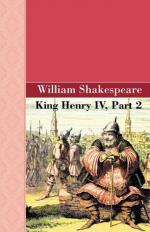|
This section contains 406 words (approx. 2 pages at 400 words per page) |

|
King Henry IV, Part II Summary & Study Guide Description
King Henry IV, Part II Summary & Study Guide includes comprehensive information and analysis to help you understand the book. This study guide contains the following sections:
This detailed literature summary also contains Characters on King Henry IV, Part II by William Shakespeare.
One of the most popular characters ever created by Shakespeare is the fat old knight Sir John Falstaff, who was appealing to Elizabethan theatergoers and remains so with audiences today. Critics have observed that his popularity is partly the result of his multifaceted personality. He seems cowardly when he runs from the Gadshill robbery in Henry IV, Part One, yet his actions suggest bravery when he appears twice on the battlefieldat Shrewsbury in Henry IV, Part One and then again outside the forest of Gaultree in Henry IV, Part Two. He is dishonest and insensitive in his dealings with Shallow in Henry IV, Part Two, but his affection for both Doll Tearsheet (Henry IV, Part Two) and Prince Hal (Henry IV, Part One and Two) appears to be genuine.
Falstaff is also appealing because he is so outrageous. When caught in a lie or an insult, he usually manages to come up with an unbelievable but witty excuse, as he does after exaggerating the facts of the Gadshill robbery in Henry IV, Part One and when he slanders Hal and Poins at the Boar's Head Tavern in Henry IV, Part Two. As Poins warns the prince in Henry IV, Part Two"my lord, [Falstaff] will drive you out of your revenge and turn all to a merriment..." if he is allowed to get away with it (II.iv.297-98).
According to most accounts, Falstaff was extremely popular in Elizabethan times. In fact he is the star of Shakespeare's The Merry Wives of Windsor, which may have been written, as some people suggest, for the same reason some movie sequels or television spin-offs are produced: to capitalize on the popularity of a character. Modern audiences may be startled when Hal, newly crowned as king, sharply rejects Falstaff at the end of Henry IV, Part Two. After all, how can he say such cruel things to an old friend who has been the source of so much amusement? Critics point out, however, that Elizabethan audiences were perhaps less sentimental about this issue than we are today. Ruled by a monarch themselves, the audiences in Shakespeare's time probably understood that with his accession to the throne, Prince Hal did not become "King Hal" (as Falstaff calls him in V.v.41) but is transformed into King Henry, who must make a clean break with his notorious past and turn completely to the business of governing the country.
Read more from the Study Guide
|
This section contains 406 words (approx. 2 pages at 400 words per page) |

|



